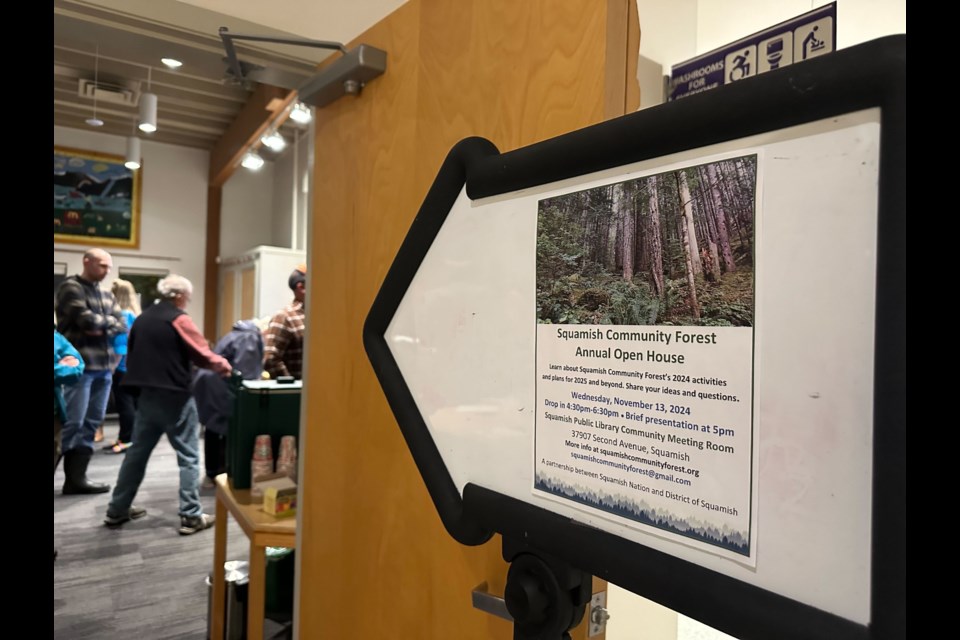If you stopped by the Squamish Public Library on Nov. 13, you may have found yourself in the thick of a lively open house hosted by the Squamish Community Forest. The event offered a space for locals to get the inside scoop on the forest’s first year of operations and share their thoughts on what’s next.
In Dec. 2022, the Squamish Community Forest received a 25-year licence from the Province of British Columbia. This licence, called a Community Forest Agreement (CFA), gives them the exclusive right to harvest timber in a specific area.
They are allowed to cut up to 20,000 cubic metres of timber each year. The licence can be renewed every 10 years, ensuring long-term forest management.
“We’re here to listen,” said Sarah Weber, the Squamish Community Forest project manager. “This forest belongs to the community, and we want to make sure everyone feels involved.”
And now, with operations in full swing, community members are being invited to shape its future.
Governance and operations
According to Weber, the community forest operates under an area-based tenure, covering forested lands east of Squamish, including areas near Cat Lake, Garibaldi Park, and the Sea to Sky Gondola.
“This tenure is held by a community-based organization formed through the partnership between the Sḵwx̱wú7mesh Úxwumixw (Squamish Nation) and the District of Squamish,” she said.
The organization is governed by a board of directors who set policy direction.
On the board are:
- Chair Armand Hurford (District of Squamish mayor)
- Rick Jaccard (Sḵwx̱wú7mesh Nation)
- Kathleen Edwards (Sḵwx̱wú7mesh Nation )
- Lauren Greenlaw (District of Squamish councillor)
A historic partnership
“This is the first-ever collaboration between the municipality and the Sḵwx̱wú7mesh Nation,” said Hurford.
“It’s historic, and I’m incredibly proud of what we’ve achieved together.”
Hurford highlighted the long journey to bring the project to life.
“Several mayors before me worked on this. I think I’m the eighth mayor involved in this initiative,” he said.
“Forestry is incredibly complex. The licensing process alone required years of studies, reports, and planning. But in the end, we made it happen.”
Sustainable and climate-resilient forestry
Weaver outlined the forest’s sustainable management practices.
“We use smaller patch cuts and retention logging,” Weber said.
“We’re very mindful of environmental features—we map out creeks, protect water sources, and identify wildlife habitats. Sensitive areas are left untouched.”
Adapting to climate change is another key focus for the Community Forest.
“The dry summers have been hard, and that’s a big part of our decision-making now,” Weber said. “Next year’s plan includes harvesting in areas close to the community to reduce wildfire risks, focusing on climate and fire resilience.”
Adding context to the scale of operations, Abe Litz, the planning operations forester, talked about the recent timber harvesting projects.
“The 20,000 cubic metres of timber harvested from the gondola and the Cheekye barrier projects equates to between 700 and 800 logging truckloads,” Litz said.
“Imagine seeing that many trucks rolling down the road—it’s a significant amount of wood.”
Sustainable and wildfire-focused harvest plans
The proposed harvest areas for 2025 were also a part of the discussion at the open house.
“One area, called MO1, is in the Mamquam River region, Weber said. “Another potential harvest site is near the lava flow, close to the power line right-of-way, with a focus on wildfire risk reduction.”
To enhance transparency, the community forest will use the provincial government’s new Forest Operations Mapping Portal (FOMP).
“This tool allows the public to view proposed logging activities and provides a 30-day comment period,” Weaver said. “We’ll announce these plans through The Squamish Chief and email blasts.”
“FOMP is a game-changer,” Litz said.
“It addresses public concerns about transparency in forestry operations. Now, anyone can see proposed logging activities and provide input before permits are issued.”
Partnering with FortisBC
A major initiative this year involved negotiating a compensation agreement with FortisBC for a pipeline project running through the community forest.
“Essentially, timber is being cleared for a project not directly related to our work,” Weber said.
“Fortis has agreed to take the timber to market and provide the proceeds to the community forest.”
Litz added, “The timber belongs to the community forest, so it’s a fair arrangement that benefits everyone.”
Innovating with biochar
An innovative trial was conducted this year using a portable carbonator.
“This machine burns logging residue at high temperatures to produce biochar, which is beneficial for soil health,” Weber said.
Biochar is a type of charcoal made from plant materials. It’s what is left after heating organic matter like wood or crop waste.
“Typically, such residue would be open burned, releasing smoke, but the carbonator reduces emissions and provides a useful by-product. We even spread the biochar on a rehabilitated forest road, enriching the soil there.”
Cultural and recreational values
The Sḵwx̱wú7mesh Nation’s cultural heritage plays a central role in forest management.
According to Weber, efforts are underway to “preserve cedar stands for traditional uses like bark stripping.”
Additionally, the forest supports Squamish’s mountain biking community, working with the Squamish Off-Road Cycling Association (SORCA) to ensure timber operations protect bike trails.
“We’re balancing wildlife, recreation, and cultural heritage values while aiming to innovate,” Weber said.
Balancing profit and reinvestment
The community forest operates as a self-sustaining business, with profits shared equally between the Nation and the District after covering operational expenses and reinvesting in the land and community.
“Reinvestment is a key component of the community forest model,” Hurford said.
“If there’s profit left after that, it’s split between the partners.”
For questions or suggestions about the Squamish Community Forest, visit their website or attend an upcoming public meeting to learn more about ongoing projects and future plans.
Note: The Squamish Chief has corrected the names of Sarah Weber and Abe Litz and apologizes for the error.
Bhagyashree Chatterjee is The Squamish Chief’s Indigenous affairs reporter. This reporting beat is made possible by the Local Journalism Initiative.



